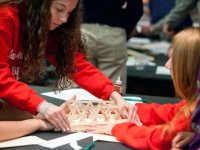Designing Learning That Matters
I'd like to invite you to try something. Stop reading for a moment and think back to a time when you were immersed in a deep learning experience. Maybe you're remembering a time when you figured out how to solve a problem? It might have been a time when you had little choice but to persevere. Changing a tire in order to continue a trip? Or maybe a time when you didn't give up until you mastered a new skill? A home project or a new video game? Now, consider what different qualities made this learning memorable.
Deep learning often happens when learners encounter experiences that challenge them to figure something out, explore new information, and create a product. (Does this match the memory you just recalled?) According to Jal Mehta:
The sad truth is that, for most of us, many of our experiences of deep learning occurred outside of school. The good news is that it is possible to bring the characteristics of deep learning to classrooms and school learning. Designing curriculum is the point when teachers can be innovative in order to create memorable and profound opportunities for their students. What does it take to design deep learning experiences that matter to students? Here are four ideas. Please share additional ideas in the comments below.
1. Use Inquiry
Chances are that your example of deep learning involved trying to figure something out. When learning is framed with problems and essential questions, there are clear reasons to pursue information. True inquiry allows for debate and encourages students to develop ideas that they can support with evidence. For example, my unit on Revolutions begins with the question, "What is a revolution?" I tell students that the dictionary won't be much help (although they are welcome to use it), but that they must come up with a definition which they can support. After the class has developed and debated ideas, we revisit these ideas regularly as we study different historic and contemporary examples of revolutions (or non-revolutions, depending on their definitions).
2. Look for Inspiration
Instead of beginning the unit-planning process by thinking of standards or by focusing solely on content, try to find examples of inspirational work in the world. Some examples:
- A particularly poignant radio piece and issues faced by transgender youth started me thinking about podcasts, so as a culminating project in a unit that included a novel with a theme of racial boundaries, I challenged my students to create a podcast about crossing boundaries.
- A newspaper article that creatively integrated text and media encouraged me to have my students create products that integrated text and media.
- A crisis around education funding in our city led me to a digital story project that invited students to share their own ideas about Education and Democracy.
Standards matter, of course, but they are easily integrated into a larger, more creative vision for learning.
3. Remember to Ask "Why?"
Educators should always have an answer for that whiny kid off to the side who wants to know, "Why are we learning this?" I try to answer this question early on, before anyone has had a chance to ask it. At its best, school learning can matter to students on many levels. It might connect to recent events, be related to students' lives, or investigate an issue that is misunderstood by many. Whatever the reason for a unit, make sure that it's clear to you and clear to students.
4. Let Them Loose!
Chances are that the example of deeper learning you recalled when you started reading this post was not something you were forced to do. Choice and personal expression are powerful ways of allowing students to find themselves in their own learning. Project-based learning can transform old visions of school and make learning about more than retaining information. As I've said before, my students regularly amaze me with their abilities, their commitment to their work, and the products that they create. Jasmin and Kia are two examples of students who took a project idea beyond my expectations.
There is nothing inherently engaging, creative, or fun about school. In fact most school experiences are remarkably unmemorable. Yet school learning can be transformative, and school can help students discover themselves and their abilities. Our work as educators is to design experiences that allow this to happen.
How do you lead your students to deep learning?
